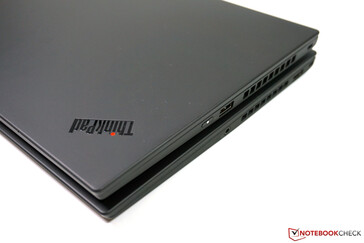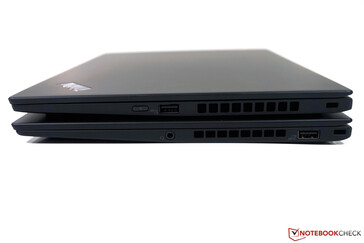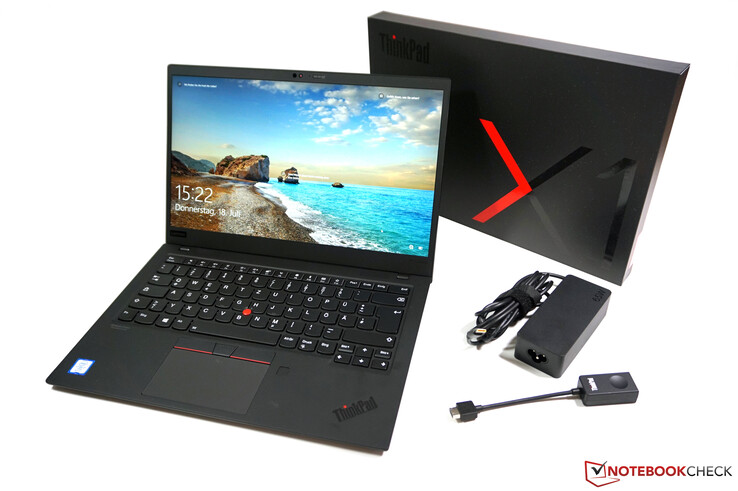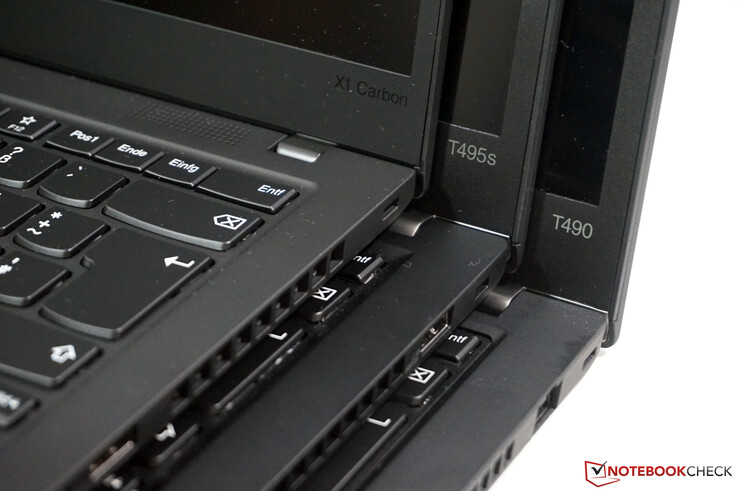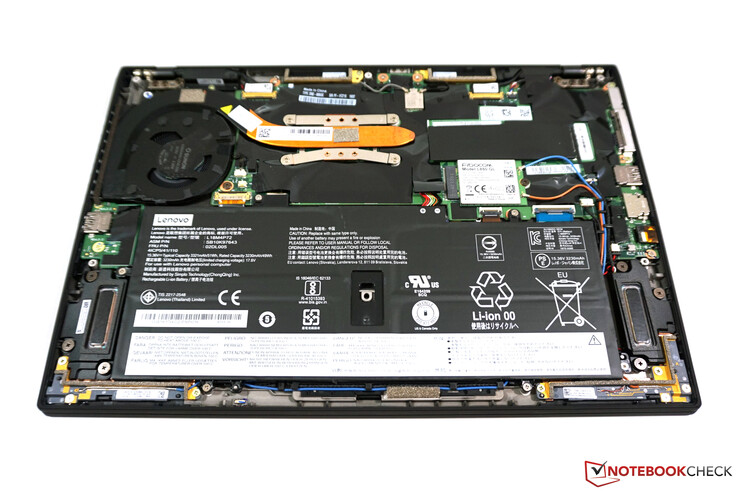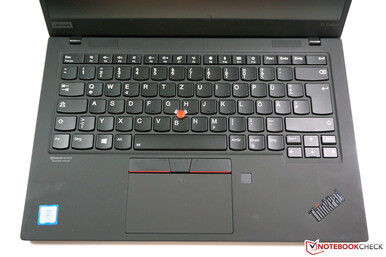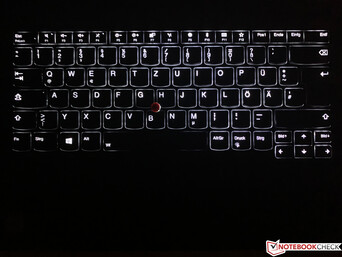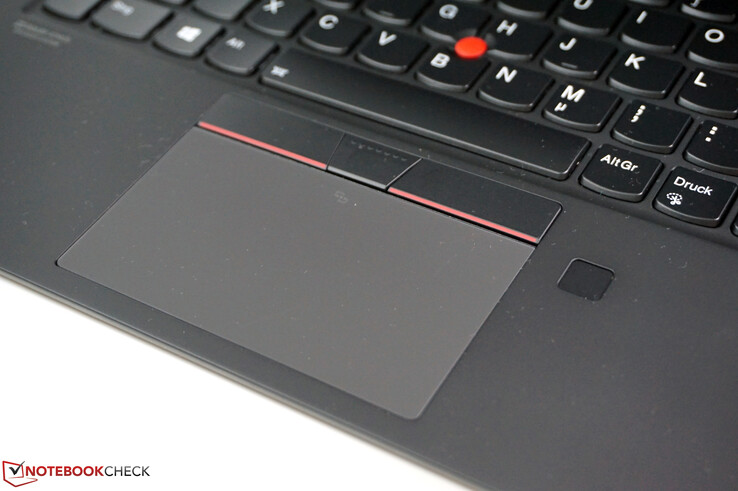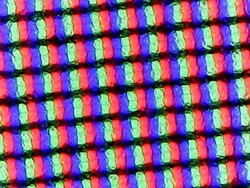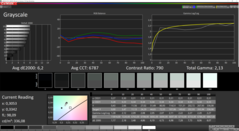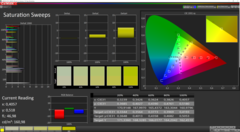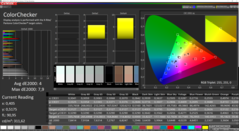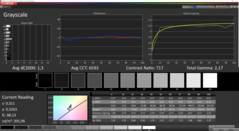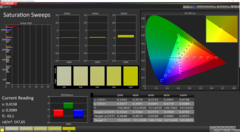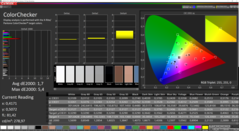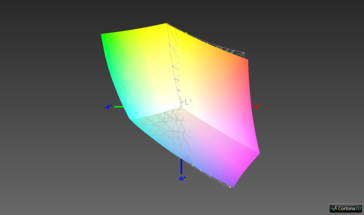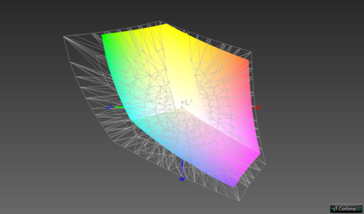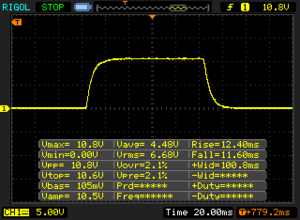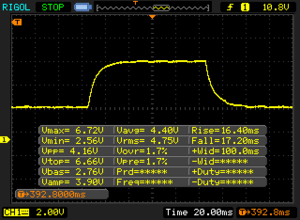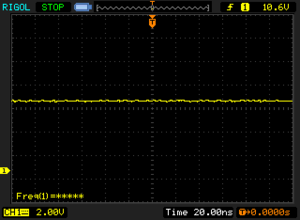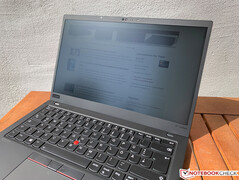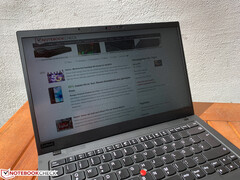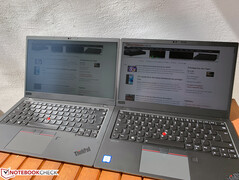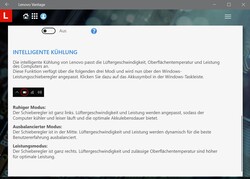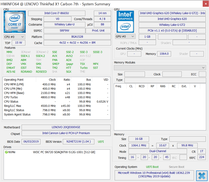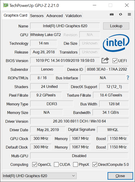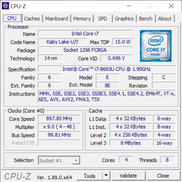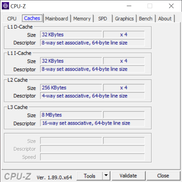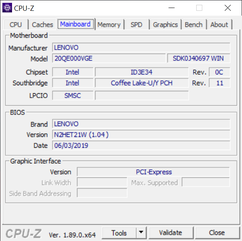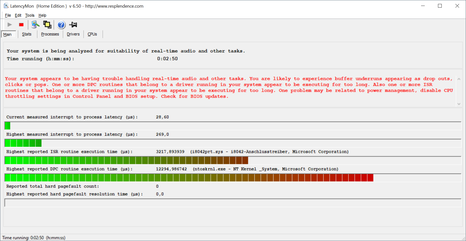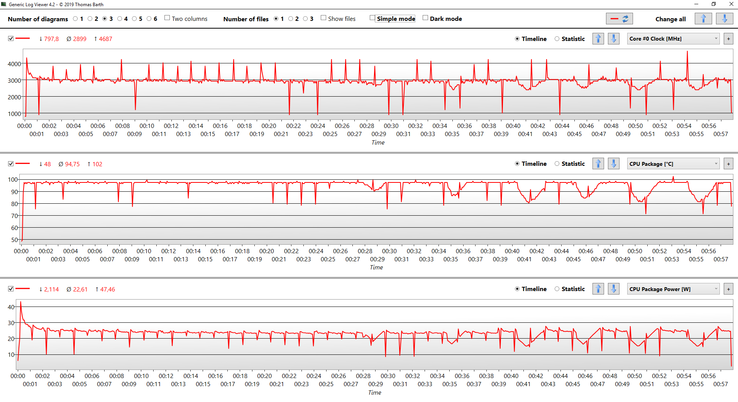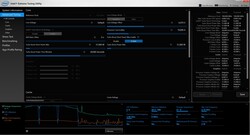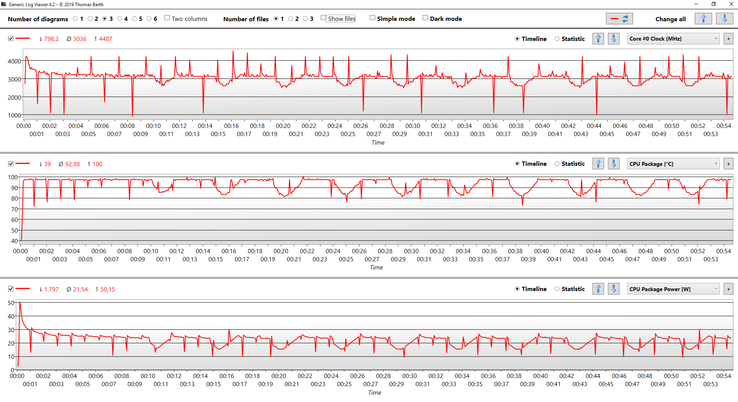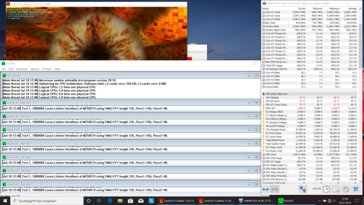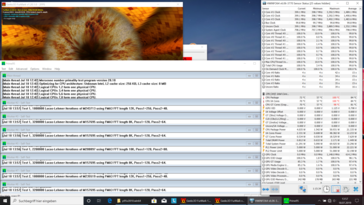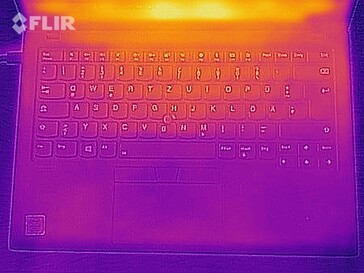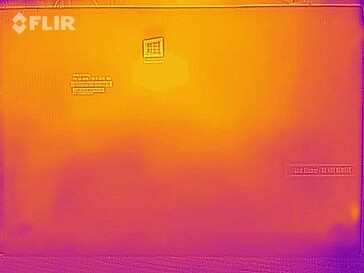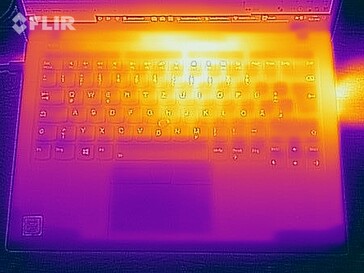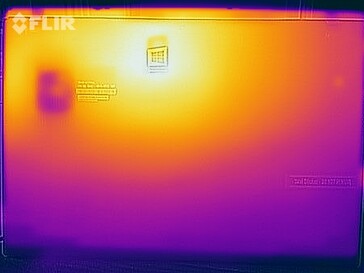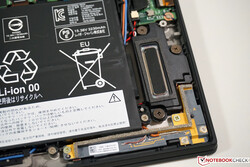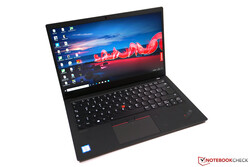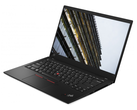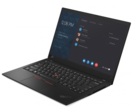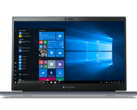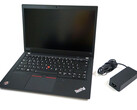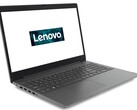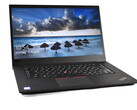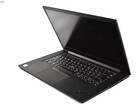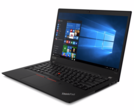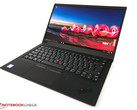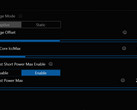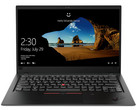Lenovo ThinkPad X1 Carbon 2019 WQHD Live Review: Still the reference among business laptops?
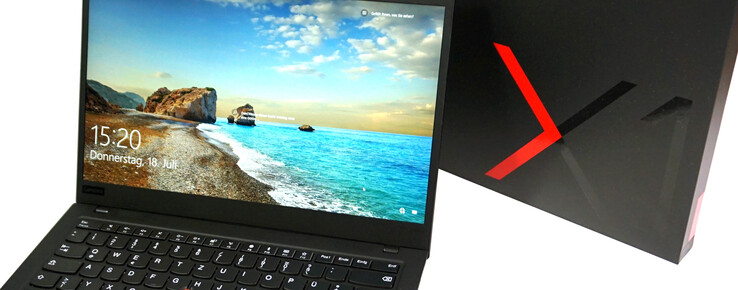
Both the ThinkPad X1 Carbon 2017 and 2018 used the same chassis (except for some visual changes), so Lenovo created a completely overhauled design for the 7th generation of its business laptop. The result is a very portable 14-inch notebook with a weight of just ~1.1 kg, which does not make any compromises in terms of functionality, at least according to the manufacturer.
Our review unit today carries the designation ThinkPad X1 Carbon 2019 20QE000VGE and it features a Core i7 processor, 16 GB RAM, and a 512 GB NVMe-SSD. We have the matte WQHD panel with 2560 x 1440 pixels, which is already familiar from the previous model. The new carbon fiber design on the lid is only available on models with the optional 4K UHD screen; all the other models feature the familiar black design.
We compare the new ThinkPad X1 Carbon 2019 with its predecessor as well as the current ThinkPad T490s/T495s. We are still waiting for the updated competitors, so we will use the HP EliteBook x360 1040 G5 and the Dell Latitude 7490 for now.
We want to present our initial test results/impressions of the new ThinkPad X1 Carbon 2019 and we will update the article over the next couple of days with all our usual tests. We also plan to test the Linux compatibility, but please leave a comment if you have further suggestions or questions.
We will receive the entry-level SKU of the X1 Carbon with the LowPower 1080p screen (400 nits) next week, but the 4K model is a bit delayed. Lenovo currently has no RRP for our configuration, but a corresponding unit in the online shop of the manufacturer retails for about 2450 Euros.
Changelog:
- July 20th: Comparison with T490 & T495s, temperatures, fan, battery runtime
- July 23rd: Display measurements, CPU performance, system performance, speakers, additional battery tests
- July 25th: Case, comparison with the X1 Carbon 2018, input devices, outdoor pictures, undervolting, additional battery tests
Case - New, but still hardly different
Lenovo equipped the ThinkPad X1 Carbon 7th Gen with a completely new chassis. It is lighter and a bit more compact, but to be honest, the differences are very small and you will have a hard time noticing it. In addition to the 2019 X1 Carbon, we also have the predecessor here in our editorial office and it is not easy to spot the new model (in terms of handling), even in a direct comparison. The design is also pretty much the same, because the black surfaces are identical. Only the X1 Carbon 2019 with the 4K HDR screen gets the new carbon fiber lid design, but this is only a visual difference.
It is good that the slimmer chassis did not really affect the stability or the build quality. The stability and torsion resistance of the lid is identical in a direct comparison with the 2018 X1 Carbon, but the center area of the base unit is slightly more flexible. This won't be a big issue in everyday scenarios, however, unless you type with a lot of force. The display hinges were changed as well and are now a bit firmer (also on the second review unit with the 400 nits display). this means the base will be lifted when you try to open the lid with one hand.
Lenovo unfortunately does not use the surface coating from the ThinkPad T490s for the new X1 Carbon, which was very effective against fingerprints and dirt. This means you will have to clean the surfaces of the X1 Carbon from time to time. Similar to the current ThinkPad X1 Yoga 2019 (where the construction of the base unit is almost identical), Lenovo uses two different versions of the base unit. The microSD card reader was completely removed, so SKUs without an LTE module will be shipped without a SIM tray at the back. We cannot really understand why Lenovo did not keep the old solution where we did at least get a microSD reader, but now uses two different case instead.
In addition to our comparison pictures, you can also see that there is not a big difference between the case sizes of the 2018 and 2019 X1 Carbon in our diagram. You might notice the slimmer case (-1mm), but even that is tricky to spot. Still, the ThinkPad X1 Carbon is once again an extremely compact 14-inch business laptop and the weight in particular is a big advantage here. For comparison: The HP EliteBook x360 1040 G5 has an even slightly smaller footprint, but is about 300 grams heavier. Both the ThinkPad T490s as well as the Dell Latitude 7490 are noticeably bigger and heavier in comparison.
X1 Carbon vs. T495s vs. T490
Maintenance
It is comparatively easy to remove the bottom cover, which is only secured by five regular Philips screws. The lid pops up a bit after you loosen the screws and you can just lift it up. We are very happy about that, especially after the tricky access to the internals of the ThinkPad T490. Once you are inside, there is unfortunately not much to do. You can access the fan, the battery, the M.2-SSD, and the M.2 WWAN module. The wireless module on the other hand is soldered onto the mainboard and a part of its functionality is handled by the CPU.
Input Devices - Slimmer chassis affects the keyboard quality
The keyboard of the current ThinkPad X1 Carbon 2019 looks identical from the outside. You still get the typical chiclet keyboard with slightly concave keys and a two-stage white background illumination, which is not completely even though (see picture below). There is unfortunately still no brightness sensor for the illumination. We still praised the input of the 2018 model thanks to its rich typing experience with a comparatively long key travel, which is not a matter of course for a slim device. In combination with the very sturdy base unit, you could enjoy an excellent typing experience with a well-defined feedback.
Because of the slimmer chassis, however, Lenovo had to reduce the key travel from 1.8 to 1.5 mm and the height of the key caps was also reduced from 5.3 to 4.5 mm. To be completely clear: We are moaning on a very high level here, and the keyboard is still very good, especially in comparison with the rivals, but the typing experience was better on the 2018 X1 Carbon. You simple notice the limited key travel and the inputs appear to be slightly more clattery overall.
Touchpad & TrackPoint
The design of the TrackPoint buttons is another difference. They are now completely flat, which is definitely a matter of taste and it is not necessarily a bad thing. However, the buttons are looser compared to the X1 Carbon 2018, which affects the precision of inputs. The left TrackPoint button of our unit also tends to be stuck in the lower left corner, which is particularly annoying when you want to execute double clicks. Our second review unit (both touchpads/TrackPoints are from ELAN) is better in this respect and the button does not get stuck, but they still have some wiggle room and also produce a louder clicking noise. It is possible that we experience issues of the initial batches (we are reviewing some of the first units), but this should not be an issue for a flagship laptop from a major manufacturer.
The touchpad itself once again works very well and offers good gliding capabilities. You can press it down physically in the lower half, which once again produces a very rich click and it does not sound cheap. A direct comparison between the two generations did not reveal a difference. It is a Windows Precision pad, so there are no problems with the execution of inputs or gestures with up to four fingers.
Display - X1 Carbon 2019 with WQHD panel from the predecessor
Lenovo offers a total of five different display for the 2019 X1 Carbon. Two of them were already available for the predecessor, the 1080p touch screen with a luminance of 300 nits and the matte WQHD panel from our test unit. The brightness is once again 300 nits, which is darker compared to the default panel (1080p, 400 nits). There is also an optional FHD panel with a privacy filter (also 400 nits, not available yet) as well as the new 4K UHD HDR screen with a rated luminance of 500 nits.
Subjectively, the WQHD panel is a very good screen for a business laptop: colors are rich, the contents are sharp and there are no problems with ghosting due to slow response times (contrary to some of the new LowPower FHD panels). The new screens easily pass the measured average luminance of slightly more than 300 nits though. We are also a bit disappointed by the comparatively high black value, which results in a contrast ratio of just 786:1. This is once again not bad for a business laptop, but it could be much better. Good: There is no sign of backlight bleeding.
| |||||||||||||||||||||||||
Brightness Distribution: 88 %
Center on Battery: 337 cd/m²
Contrast: 786:1 (Black: 0.43 cd/m²)
ΔE ColorChecker Calman: 4 | ∀{0.5-29.43 Ø4.78}
calibrated: 1.7
ΔE Greyscale Calman: 6.2 | ∀{0.09-98 Ø5}
97.8% sRGB (Argyll 1.6.3 3D)
68.1% AdobeRGB 1998 (Argyll 1.6.3 3D)
73.8% AdobeRGB 1998 (Argyll 3D)
97.8% sRGB (Argyll 3D)
72.5% Display P3 (Argyll 3D)
Gamma: 2.13
CCT: 6787 K
| Lenovo ThinkPad X1 Carbon 2019-20QE000VGE LP140QH2-SPD1, , 2560x1440, 14" | Lenovo ThinkPad X1 Carbon 2018-20KGS5DU00 LP140QH2-SPB1, , 2560x1440, 14" | Lenovo ThinkPad X1 Carbon G6-20KG0025UK Lenovo LEN40A9 / AUO B140HAK02.3, , 1920x1080, 14" | Lenovo ThinkPad X1 Carbon 2018-20KGS03900 B140QAN02.0, , 2560x1440, 14" | Lenovo ThinkPad T490s-20NYS02A00 B140HAN05.7, , 1920x1080, 14" | HP Elitebook x360 1040 G5 AU Optronics AUO533D, , 1920x1080, 14" | Dell Latitude 7490 AUO503D (D04YD_B140HAN), , 1920x1080, 14" | |
|---|---|---|---|---|---|---|---|
| Display | 0% | -5% | 19% | -5% | -9% | -6% | |
| Display P3 Coverage (%) | 72.5 | 72.7 0% | 68.3 -6% | 87.7 21% | 67.1 -7% | 64.3 -11% | 66.6 -8% |
| sRGB Coverage (%) | 97.8 | 97.9 0% | 94.9 -3% | 100 2% | 97.6 0% | 94.1 -4% | 96.8 -1% |
| AdobeRGB 1998 Coverage (%) | 73.8 | 74.6 1% | 69.3 -6% | 99.9 35% | 68.5 -7% | 65.5 -11% | 67.9 -8% |
| Response Times | -11% | -12% | -60% | -73% | -77% | -29% | |
| Response Time Grey 50% / Grey 80% * (ms) | 33.6 ? | 38 ? -13% | 40 ? -19% | 59.2 ? -76% | 61.6 ? -83% | 70.8 ? -111% | 41.6 ? -24% |
| Response Time Black / White * (ms) | 24 ? | 26 ? -8% | 25 ? -4% | 34.4 ? -43% | 38.8 ? -62% | 34.4 ? -43% | 32 ? -33% |
| PWM Frequency (Hz) | 735 ? | ||||||
| Screen | -4% | 25% | 44% | 29% | 23% | -1% | |
| Brightness middle (cd/m²) | 338 | 316 -7% | 298 -12% | 578 71% | 391 16% | 416.3 23% | 308.6 -9% |
| Brightness (cd/m²) | 315 | 311 -1% | 287 -9% | 533 69% | 389 23% | 400 27% | 294 -7% |
| Brightness Distribution (%) | 88 | 84 -5% | 91 3% | 84 -5% | 87 -1% | 89 1% | 89 1% |
| Black Level * (cd/m²) | 0.43 | 0.35 19% | 0.2 53% | 0.38 12% | 0.23 47% | 0.29 33% | 0.23 47% |
| Contrast (:1) | 786 | 903 15% | 1490 90% | 1521 94% | 1700 116% | 1436 83% | 1342 71% |
| Colorchecker dE 2000 * | 4 | 4.5 -13% | 2.19 45% | 1.9 52% | 3.4 15% | 2.69 33% | 6.07 -52% |
| Colorchecker dE 2000 max. * | 7.9 | 10.3 -30% | 4.39 44% | 3.8 52% | 4.7 41% | 4.95 37% | 10.58 -34% |
| Colorchecker dE 2000 calibrated * | 1.7 | 1.6 6% | 1.67 2% | 0.8 53% | 1.1 35% | 2.13 -25% | 1.67 2% |
| Greyscale dE 2000 * | 6.2 | 7.7 -24% | 1.97 68% | 3 52% | 4 35% | 2.9 53% | 7.3 -18% |
| Gamma | 2.13 103% | 2.2 100% | 2.43 91% | 2.14 103% | 2.49 88% | 2.4 92% | 2.061 107% |
| CCT | 6787 96% | 6639 98% | 6571 99% | 6377 102% | 6809 95% | 6623 98% | 7269 89% |
| Color Space (Percent of AdobeRGB 1998) (%) | 68.1 | 68.6 1% | 62 -9% | 88.8 30% | 62.4 -8% | 60.1 -12% | 62 -9% |
| Color Space (Percent of sRGB) (%) | 97.8 | 97.9 0% | 95 -3% | 100 2% | 97.4 0% | 94.5 -3% | 97 -1% |
| Total Average (Program / Settings) | -5% /
-4% | 3% /
15% | 1% /
26% | -16% /
10% | -21% /
4% | -12% /
-5% |
* ... smaller is better
The calibration of the screen could also be better out of the box since there is some potential here. We can determine comparatively high grayscale deviations compared to the sRGB reference color space with our X-Rite i1 Pro2 photospectrometer. There is also a slight color cast towards green/blue, bit you will only notice it if you are used to a calibrated panel.
Our calibration improves the results considerably, only 100% red is still deviating from the target value (DeltaE smaller 3). However, one drawback of the calibration is the reduced display brightness (~30 nits). Some mobile picture editing is possible thanks to the almost full sRGB coverage, but this is also the case for the new 1080p screens.
Display Response Times
| ↔ Response Time Black to White | ||
|---|---|---|
| 24 ms ... rise ↗ and fall ↘ combined | ↗ 12.4 ms rise | |
| ↘ 11.6 ms fall | ||
| The screen shows good response rates in our tests, but may be too slow for competitive gamers. In comparison, all tested devices range from 0.1 (minimum) to 240 (maximum) ms. » 53 % of all devices are better. This means that the measured response time is worse than the average of all tested devices (20.2 ms). | ||
| ↔ Response Time 50% Grey to 80% Grey | ||
| 33.6 ms ... rise ↗ and fall ↘ combined | ↗ 16.4 ms rise | |
| ↘ 17.2 ms fall | ||
| The screen shows slow response rates in our tests and will be unsatisfactory for gamers. In comparison, all tested devices range from 0.165 (minimum) to 636 (maximum) ms. » 45 % of all devices are better. This means that the measured response time is similar to the average of all tested devices (31.6 ms). | ||
Screen Flickering / PWM (Pulse-Width Modulation)
| Screen flickering / PWM not detected | |||
In comparison: 53 % of all tested devices do not use PWM to dim the display. If PWM was detected, an average of 8118 (minimum: 5 - maximum: 343500) Hz was measured. | |||
The WQHD panel of the ThinkPad X1 Carbon has a matte surface and can be used outdoors. The brightness is not reduced when you deactivate the adaptive brightness control in the Intel driver. We took some pictures in the bright summer sun and you can still see something even in this worst-case scenario. However, it is much more comfortable when you turn the display.
We also have the review unit with the 400 nits 1080p screen here and wanted to see if you can actually spot the difference between the two panels outdoors. The answer is definitely yes, so you might want tor prefer the X1 Carbon with the 1080p screen if you often use the device in very bright environments or outdoors.
Performance
The chapter performance is not that much different from the previous model. Lenovo implements Intel's latest Whiskey Lake CPUs, but still combines them with LPDDR3 memory. All the graphics calculations are handled by the integrated Intel GPU, which is completely sufficient for standard office tasks. So far, Lenovo did not reveal any plans for a ThinkPad X1 Carbon with AMD CPUs.
It looks like the drivers are not perfectly optimized yet, because the PowerLimits (both Burst and longterm) are very high at 51 Watts. This results in heavily fluctuating clocks under load, but we will have a closer look at them in the individual sections. There is another change in Lenovo's Vantage Software. We have now seen multiple new ThinkPads where the software just refers to the standard Windows Performance Slider when you go the item Intelligent Cooling (see screenshot).
There are currently some issues with the latencies, because the tool LatencyMon shows high peaks both with an activated or deactivated wireless connection. The previous model was better in this regard, so we hope Lenovo will address this issue with a update. The first Bios update to version 1.04 did not improve the situation.
Processor - ThinkPad with vPro Core i7
The 2019 ThinkPad X1 Carbon is available with four different Whiskey Lake CPUs from Intel. All of them are quad-core processors with a nominal TDP of 15 Watts. Besides the regular versions Core i5-8265U and Core i7-8565U, which can also be found on most consumer laptops, Lenovo also offers the two vPro version Core i5-8365U as well as Core i7-8665U. They offer additional management features and manage slightly higher clocks. Our test model is equipped with the fastest CPU, the Core i7-8665U. It can reach a maximum Turbo clock of 4.8 GHz.
The ThinkPad x1 Carbon obviously benefits from the high clock when you only utilize one core. The result in the initial Multi test is also very good, even though the maximum Turbo clocks are not reached. This means the new model is a few percent faster than the 2018 X1 Carbon, so the slimmer chassis does not seem to affect the cooling performance.
If you are looking at the performance alone, the Core i7-8665U is certainly not worth the additional price. However, the vPro support plays a role as well and will be interesting for larger companies in particular. The CPU performance is not reduction on battery power. Attention: The Windows performance slider has to be set to Best Performance for the full CPU performance, otherwise the PowerLimits will be reduced (20/15W @Better Performance; 10/7.5W @More Battery Efficiency).
We simulate sustained CPU load with the Cinebench R15 Multi loop, and here we can see the problem of the high TDP limits. The processor is pretty much close to 100 °C all the time, which sometimes results in performance drops over the course of the test. The average score of 632 points is certainly not bad, but we are pretty sure it could be better with some optimization. We will try to fiddle with the TDP limits and also try to reduce the core voltage , but our initial results were not very successful.
Voltage Reduction via Intel XTU
Besides the adjustment of the TDP limits, you can also reduce the core voltage of the processor. Please refer to our dedicated article for more information. Attention: Every processor behaves differently and the results cannot just be transferred to other systems.
The Core i7-8665U was not the best candidate for voltage reduction, because we could only reduce the voltage by 0.070 Volts for a stable operation. The result is a slightly higher clock at the same temperature, which improves the benchmark scores. However, it does not change the basic behavior and we can still see the fluctuations.
System Performance
We can keep it short in this section, because the system runs very well thanks to the fast components and that's what you can expect from a modern and expensive laptop in 2019. We did not encounter any problems so far.
| PCMark 8 Home Score Accelerated v2 | 3823 points | |
| PCMark 8 Creative Score Accelerated v2 | 5120 points | |
| PCMark 8 Work Score Accelerated v2 | 4696 points | |
| PCMark 10 Score | 4005 points | |
Help | ||
Emissions
System Noise
The fan of the new ThinkPad X1 Carbon 2019 is fortunately pretty restrained, because it is usually deactivated while idling or during low workloads. Even shorter peak load is is often handled without the use of the fan (like the installation of an app). The annoying fan burst we on mains we noticed with some recent ThinkPad models is no problem on the new X1 Carbon so far.
It takes a while until you can notice the fan under load. We determined three fans speeds, one at an barely audible 28.6 dB(A), one at 31.5 and one at 33.1 dB(A). The fan noise itself is neither annoying nor high-pitched. Our test model did not have any issues with other electronic noises like coil whining.
Noise level
| Idle |
| 28.4 / 28.4 / 28.6 dB(A) |
| Load |
| 31.5 / 33.1 dB(A) |
 | ||
30 dB silent 40 dB(A) audible 50 dB(A) loud |
||
min: | ||
| Lenovo ThinkPad X1 Carbon 2019-20QE000VGE UHD Graphics 620, i7-8665U, WDC PC SN720 SDAQNTW-512G | Lenovo ThinkPad X1 Carbon G6-20KG0025UK UHD Graphics 620, i5-8350U, Lenovo LENSE20256GMSP34MEAT2TA | Lenovo ThinkPad X1 Carbon 2018-20KGS03900 UHD Graphics 620, i5-8550U, Samsung SSD PM981 MZVLB512HAJQ | Lenovo ThinkPad T490s-20NYS02A00 UHD Graphics 620, i5-8265U, Intel SSD Pro 7600p SSDPEKKF512G8L | HP Elitebook x360 1040 G5 UHD Graphics 620, i7-8650U, Samsung SSD PM981 MZVLB512HAJQ | Dell Latitude 7490 UHD Graphics 620, i5-8350U, Toshiba KSG60ZMV256G | |
|---|---|---|---|---|---|---|
| Noise | -4% | -6% | -5% | -2% | -2% | |
| off / environment * (dB) | 28.4 | 30.25 -7% | 28.9 -2% | 29.4 -4% | 28.3 -0% | 28.2 1% |
| Idle Minimum * (dB) | 28.4 | 30.25 -7% | 28.9 -2% | 29.4 -4% | 28.3 -0% | 28.2 1% |
| Idle Average * (dB) | 28.4 | 30.25 -7% | 28.9 -2% | 29.4 -4% | 28.3 -0% | 28.2 1% |
| Idle Maximum * (dB) | 28.6 | 30.25 -6% | 32.5 -14% | 30.9 -8% | 28.3 1% | 28.7 -0% |
| Load Average * (dB) | 31.5 | 31.3 1% | 35.1 -11% | 33.3 -6% | 32.6 -3% | 29.9 5% |
| Load Maximum * (dB) | 33.1 | 31.3 5% | 35.1 -6% | 33.3 -1% | 36.6 -11% | 40.2 -21% |
* ... smaller is better
Temperature
The surface temperatures are low across the board while idling and under light workloads. However, the upper center area of the base unit can get pretty warm at 47 °C under load, which is definitely noticeable under load. The bottom stays a bit cooler, but you should not use the device on your lap for longer periods of time in extreme scenarios. The fan exhaust is located at the right side of the chassis, so mouse users (right handers) could get a warm hand.
Our stress test with the two synthetic tools Prime95 as well as FurMark shows a heavily fluctuating performance. Because of the high PowerLimits, the processor constantly tries to reach very high locks, which obviously results in high temperatures. This causes a big performance drop and the loop continues. The CPU does not reach a steady level over the course of the stress test, but the power consumption of the processor fluctuates between 4-51 Watts with an average value of ~21 Watts instead.
(-) The maximum temperature on the upper side is 47.9 °C / 118 F, compared to the average of 34.3 °C / 94 F, ranging from 21.2 to 62.5 °C for the class Office.
(-) The bottom heats up to a maximum of 45.9 °C / 115 F, compared to the average of 36.8 °C / 98 F
(+) In idle usage, the average temperature for the upper side is 23.9 °C / 75 F, compared to the device average of 29.5 °C / 85 F.
(+) The palmrests and touchpad are cooler than skin temperature with a maximum of 30.7 °C / 87.3 F and are therefore cool to the touch.
(-) The average temperature of the palmrest area of similar devices was 27.6 °C / 81.7 F (-3.1 °C / -5.6 F).
Speakers - ThinkPad with Dolby Atmos
The biggest difference between the old and the new ThinkPad X1 Carbon is the speaker system, which is certainly a surprise for a business laptop. The two 1W modules from the 2018 X1 Carbon have been replaced by a total of four speakers and Lenovo advertises a Dolby Atmos system. The two speakers in the front area of the bottom are now more powerful (2W each) and they are supported by two additional modules (0.8W each) above the keyboard.
The result is actually very good, and not only for a business laptop. There is no dedicated subwoofer, but there is still some bass and the sound is much richer in a direct comparison, but voices are still easy to understand. We have watched multiple trailers and listened to different songs, and the improvements are significant. If you are deciding between the 2018 and 2019 X1 Carbon, the sound alone will be reason enough to get the new model for some users.
In addition to the speakers, you also get the Dolby Atmos app, which offers several presets and an individual equalizer. The dynamic preset, which adjusts the sound automatically to the source, works very well and a manual selection is usually not required.
Lenovo ThinkPad X1 Carbon 2019-20QE000VGE audio analysis
(±) | speaker loudness is average but good (76.8 dB)
Bass 100 - 315 Hz
(±) | reduced bass - on average 11.2% lower than median
(±) | linearity of bass is average (7.1% delta to prev. frequency)
Mids 400 - 2000 Hz
(±) | higher mids - on average 5.1% higher than median
(+) | mids are linear (5.4% delta to prev. frequency)
Highs 2 - 16 kHz
(+) | balanced highs - only 2.9% away from median
(±) | linearity of highs is average (9.1% delta to prev. frequency)
Overall 100 - 16.000 Hz
(±) | linearity of overall sound is average (16.7% difference to median)
Compared to same class
» 20% of all tested devices in this class were better, 8% similar, 72% worse
» The best had a delta of 7%, average was 21%, worst was 53%
Compared to all devices tested
» 28% of all tested devices were better, 7% similar, 65% worse
» The best had a delta of 4%, average was 24%, worst was 134%
Lenovo ThinkPad X1 Carbon 2018-20KGS03900 audio analysis
(+) | speakers can play relatively loud (83.6 dB)
Bass 100 - 315 Hz
(-) | nearly no bass - on average 25.9% lower than median
(±) | linearity of bass is average (9.8% delta to prev. frequency)
Mids 400 - 2000 Hz
(+) | balanced mids - only 3.8% away from median
(±) | linearity of mids is average (9% delta to prev. frequency)
Highs 2 - 16 kHz
(+) | balanced highs - only 2.1% away from median
(+) | highs are linear (4% delta to prev. frequency)
Overall 100 - 16.000 Hz
(±) | linearity of overall sound is average (18.7% difference to median)
Compared to same class
» 33% of all tested devices in this class were better, 6% similar, 61% worse
» The best had a delta of 7%, average was 21%, worst was 53%
Compared to all devices tested
» 42% of all tested devices were better, 8% similar, 51% worse
» The best had a delta of 4%, average was 24%, worst was 134%
Energy Management - X1 Carbon 2019 with smaller battery
Battery Runtime
The smaller chassis also affects the battery capacity. While the 2018 X1 Carbon was equipped with a 57 Wh module, the new one only gets a 51 Wh battery. We can see the effect in our battery tests. You can expect about 80 minutes under load and our realistic WLAN test (luminance set to 150 nits; 72% for our panel) run for about 8 hours on one charge. This means the new X1 Carbon is beaten by all the models of the previous X1 Carbon and the ThinkPad T490s with the LowPower FHD screen also lasts much longer (+2 hours). The WLAN runtime drops to around 6 hours when you use the maximum brightness.
The performance is a bit better in the video test where we run a loop of the short movie Big Buck Bunny. The luminance is once again set to 150 nits and the ThinkPad X1 Carbon lasts almost 10 hours.
| Lenovo ThinkPad X1 Carbon 2019-20QE000VGE i7-8665U, UHD Graphics 620, 51 Wh, 2560x1440 | Lenovo ThinkPad X1 Carbon 2018-20KGS5DU00 i5-8550U, UHD Graphics 620, 57 Wh, 2560x1440 | Lenovo ThinkPad X1 Carbon G6-20KG0025UK i5-8350U, UHD Graphics 620, 57 Wh, 1920x1080 | Lenovo ThinkPad X1 Carbon 2018-20KGS03900 i5-8550U, UHD Graphics 620, 57 Wh, 2560x1440 | Lenovo ThinkPad T490s-20NYS02A00 i5-8265U, UHD Graphics 620, 57 Wh, 1920x1080 | HP Elitebook x360 1040 G5 i7-8650U, UHD Graphics 620, 56 Wh, 1920x1080 | Dell Latitude 7490 i5-8350U, UHD Graphics 620, 60 Wh, 1920x1080 | Average of class Office | |
|---|---|---|---|---|---|---|---|---|
| Battery runtime | 10% | 25% | 10% | 29% | 74% | 11% | 46% | |
| H.264 (h) | 9.8 | 11 12% | 9.4 -4% | 13.9 42% | 14.9 ? 52% | |||
| WiFi v1.3 (h) | 8.2 | 9 10% | 10.4 27% | 8.7 6% | 10.1 23% | 10.4 27% | 9.1 11% | 12.6 ? 54% |
| Load (h) | 1.4 | 1.9 36% | 1.8 29% | 1.7 21% | 3.1 121% | 1.849 ? 32% |
First Impressions
Without a direct comparison with the 2018 model, you will hardly notice the size/weight advantage of the 7th generation ThinkPad X1 Carbon to be honest. Both the stability as well as the build quality of the new chassis are great, but the keyboard was better on the old model.
We are already familiar with the screen from last year and the quality is still good (even though you should calibrate it), but considering the brighter entry-level FHD panel, we would have liked to see a brighter backlight for the more expensive WQHD option as well.
The emissions are also good so far; the fan is not annoying and the speakers have been improved.
The battery runtime unfortunately suffers from the smaller battery. We are already eager to find out how the LowPower-1080p screen will perform in this respect.




